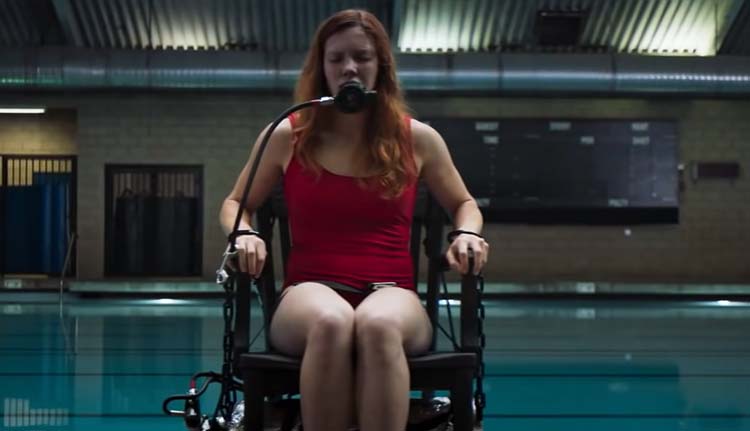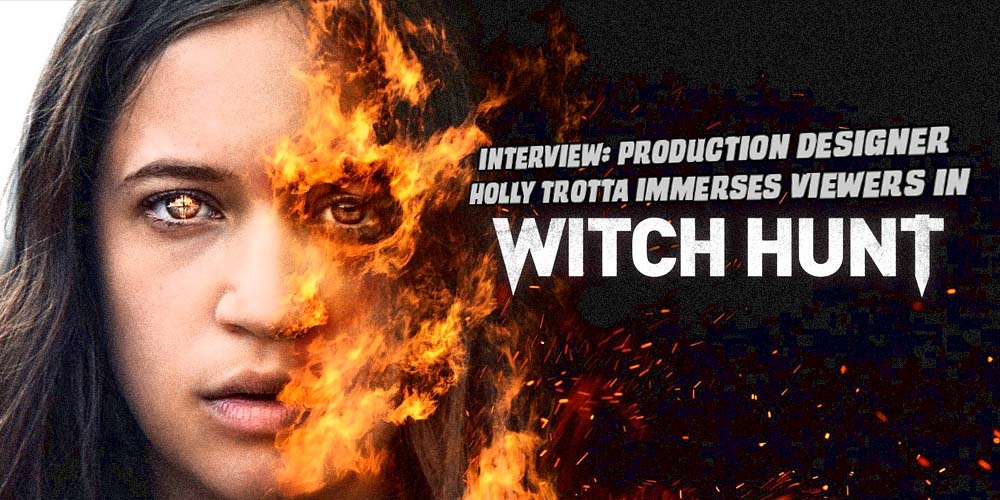In the new film Witch Hunt written and directed by Elle Callahan (Head Count) and starring Elizabeth Mitchell (Lost), witches exist alongside us in the present day, but they’re persecuted and hunted. Production designer Holly Trotta brought this wicked world to life.
It’s modern-day America, and witches are real, but they’re hunted by an official organization known as the Bureau of Witchcraft Investigation (BWI). Martha Goode (Mitchell) and her teenage daughter Claire (Gideon Adlon, The Craft) are a family with a secret; they smuggle witches out of the country and into Mexico, where witchcraft isn’t persecuted. However, standing in the way during this politically-flavored horror-thriller is Hawthorne, an agent determined to stop Martha’s illegal activities and kill any witch he finds, including young Claire, who’s developing powers of her own.
PopAxiom spoke with Holly Trotta about becoming a production designer and creating the world of Witch Hunt.
Inner Workings
Holly grew up with a fine artist mother and engineer father. “So, it was built into my DNA that there was an artistic side and a technical side.”
However, Holly struggled with “learning disabilities, and I was dyslexic. So I struggled a lot in school with reading, writing, and arithmetic.”
“I found my love of the arts,” she adds, “I went to the School of Visual Arts in Manhattan. That was amazing because I was just able to study art. Also, a lot of the faculty works in the industry. So, that’s one of the big reasons I ended up going there. So, you get to work on actual projects and things that are going to be published.”
Holly majored in advertising, but her education in that field “led me to 3D design. I fell in love with being able to make and hold things.”
“I was studying with one of my mentors,” Holly’s professional artistic career slowly took shape, “Kevin O’Callahan, who said that I should be going out and doing these things and not sitting behind a computer.”
Holly started working with Kevin “on the side while in school. I had an internship at Atlantic Records and eventually started freelancing. A lot of early on production design was segueing into music videos.”
“I didn’t want just to do music videos,” she says, “so I started getting into fashion. Coming up the ranks with set designers like Mary Howard. She’s worked with the best-of-the-best photographers in the world. I eventually designed with Mary, who gave me so much hands-on experience with sets and the inner workings.”
Fashion & Film
Holly was getting intimate perspectives on different ways to dress a scene between fashion shoots and music videos. “Fashion photography is very different from film because you’re in a moment, a vignette. In film, you’re creating a whole 3D world. So there’s a lot of similarities, but I see it as taking a set from a photo and expanding it for a film.”
“Some of the best photo sets I was on,” she adds, “were with photographers who would shoot on the RED camera and grab stills from the video. I think that’s where I thought,’ this is amazing; I want to create a world.’ So, the combination of music videos and fashion lead me down this road to production design.”
Holly’s love for film is rooted in the “narrative aspect. There’s so much backstory. You create a set for a character, and you think to yourself, ‘this person would have this furniture because they grew up in this area around this time.’ There’s so much to tell through the sets to make the sets believable. I enjoy diving into and living in these worlds.”
“Film is so collaborative,” she continues, “you’re not only in the art department and tapped to do sets but working with the director, the DP, costumes; there are so many crossovers. I love the collaborative experience.”

About Witch Hunt
It’s Holly’s collaborations that paved the way to the gritty world of Witch Hunt. “I worked with Defiant Studios on two previous films. So, Chris Abernathy, the line producer, contacted me and asked if I was interested in reading the script. I definitely was.”
“Even before pre-production started,” Holly shares, “Elle [Callahan] and I had a lot of discussions. She sent me what she was looking to do, the feel, and the inspiration. I thought it had potential to be a lot of fun.”
Witch Hunt takes place in our modern world, but “it does have this stylized look almost like a period piece.”
The film begins with a traditional scene for a movie about witches with a burning at the stake. However, just seconds into the film, that stylized look is apparent. “The burning at the stake we pulled a lot of references from American Horror Story, compiled with research and a lot of old-school photographs.”
“Elle said early on,” Holly adds, “that she did not want to feel like this was shot in California. She said, ‘I don’t want to see a single palm tree. I want this feel like it’s Salem.’ If you’ve ever been to Salem, there’s an air about the place. Granted, I went during Halloween times, so there’s that extra element, but the architecture and the vibe are special.”
Making Witch Hunt
Witch Hunt undoubtedly has a modern, western, period piece vibe. “There was a mashup of locations to create a weird sort of setting for the movie to take place.”
Later in the film, there’s another element from traditional witch stories but turned on its head with the intensity cranked up to eleven. “The dunking scenes were a particular style of furniture. It was supposed to feel like you were at a school. So, we used some older elements that you’d find in a schoolhouse and converted it to this weird chair. We modified an existing chair to create this contraption and equipment for people to test witches.”
One of Witch Hunt’s antagonists is a massive wall blocking witches from escaping into Mexico. “We created a 24-foot wide wall that was elongated in post.”
The CG process is another collaboration for Holly. “I’m working with the post-supervisor either beforehand or on set. We talk about where we need markers and green screen setups. In conjunction with on-set, post-production person working with us on the day, who makes sure that the markers are a specific length and size depending on their position. Things that are farther away need larger markers.”
Wrapping Up
“I love Wes Anderson,” Holly answers immediately when asked about directors she loves. “Everyone loves him. Legends like Tim Burton who does such weird, obscure, off-beat stories.”
Inspiration for creative professionals comes from all sorts of places. “Something that’s inspired me lately are programs such as Unreal Engine. You can do so much in it, and I’m excited by being able to learn the inner workings of that and continue to grow with the capabilities of these programs.”
“Coming from much more an old-school background,” she says, “a lot of the things that were learned were conceptual first before the technology. So, the way the world is shifting into a digital platform, it’s important to be up-to-date and stay ahead of the curve as to where things are going.”
“As a production designer,” she adds, “it’s so important to paint pictures for the directors through concepts.” That’s where things like Unreal Engine come in “It’s a great launch point.”
Holly loves dreams but says, “I think in the way of goals. It helps make things a bit more tangible. My goal is to work on larger productions for some of the big, classic studios. I have a fascination with getting involved with science fiction, too, and psychological thrillers. Those resonate with me, and anything that resonates with an artist is easier to dive into.”
Is Witch Hunt on your watch list?
Thanks to Holly Trotta and Projection PR
for making this interview possible.
Find more interviews from Ruben R. Diaz here!


